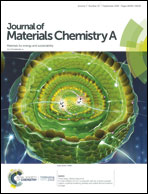Structural engineering of pyrrolo[3,4-f]benzotriazole-5,7(2H,6H)-dione-based polymers for non-fullerene organic solar cells with an efficiency over 12%†
Abstract
In this work, we have synthesized two wide band gap donor polymers based on benzo[1,2-b:4,5-b′]dithiophene (BDT) and pyrrolo[3,4-f]benzotriazole-5,7(2H,6H)-dione (TzBI), namely, PBDT-TzBI and PBDT-F-TzBI and studied their photovoltaic properties by blending them with ITIC as an acceptor. Polymer solar cell devices made from PBDT-TzBI:ITIC and PBDT-F-TzBI:ITIC exhibited power conversion efficiencies (PCEs) of 9.22% and 11.02% and while annealing at 160 °C, improved the device performances to 10.24% and 11.98%, respectively. Upon solvent annealing with diphenyl ether (DPE) (0.5%) and chlorobenzene (CB), the PCE of the PBDT-F-TzBI-based device increased to 12.12%. The introduction of the fluorinated benzodithiophene (BDT-F) moiety on the backbone of PBDT-F-TzBI improved the open circuit voltage, short circuit current and fill factor simultaneously. The high PCEs of the PBDT-F-TzBI:ITIC-based devices were supported by comparison and analysis of the optical and electronic properties, the charge carrier mobilities, exciton dissociation probabilities, and charge recombination behaviors of the devices.
![Graphical abstract: Structural engineering of pyrrolo[3,4-f]benzotriazole-5,7(2H,6H)-dione-based polymers for non-fullerene organic solar cells with an efficiency over 12%](/en/Image/Get?imageInfo.ImageType=GA&imageInfo.ImageIdentifier.ManuscriptID=C9TA06385D&imageInfo.ImageIdentifier.Year=2019)


 Please wait while we load your content...
Please wait while we load your content...